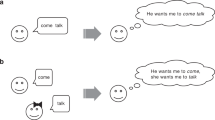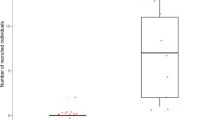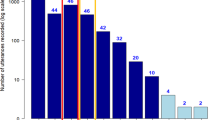Putty-nosed monkeys rely on two basic calling sounds to construct a message of utmost urgency.
Abstract
Syntax sets human language apart from other natural communication systems, although its evolutionary origins are obscure1. Here we show that free-ranging putty-nosed monkeys combine two vocalizations into different call sequences that are linked to specific external events, such as the presence of a predator and the imminent movement of the group. Our findings indicate that non-human primates can combine calls into higher-order sequences that have a particular meaning.
Similar content being viewed by others
Main
Like most forest guenons, male putty-nosed monkeys (Cercopithecus nictitans) produce two acoustically distinct loud calls (‘pyows’ and ‘hacks’) in response to a range of disturbances2,3. Males also call spontaneously, especially during morning foraging and evening travel to sleeping sites. In addition, these calls can function as alarm calls to warn the group of an approaching predator and to discourage attack3,4,5: pyows are used primarily when a leopard (Panthera pardus) is in the vicinity, and hacks are produced mainly in response to crowned eagles (Stephanoaetus coronatus) (audio files are in supplementary information).
Apart from these predator-specific call sequences, we found that males regularly combine the same two calls into a third structure, a ‘pyow–hack’ (or P–H) sequence, which usually consists of one, two or three pyows followed by up to four hacks (total mean duration 6.11±3.02 s). These P–H sequences were emitted in response both to eagles and to leopards, and were either isolated or interspersed with other sequence types. We noticed that the group of monkeys would begin to move soon after hearing a P–H sequence.
To test whether the function of the P–H call sequence could be to instigate this movement, we carried out a field experiment in which leopard growls were played to 17 different monkey groups, each consisting of several adult females with their offspring and a single adult male, to elicit calling from the adult male (for details of methods, see supplementary information). In nine groups (52.9%), the male produced call series containing at least one P–H sequence; in the other eight groups, the males also called, but no P–H sequences were produced.
Twenty minutes later, we played a second stimulus, a series of hacks from the same position to imitate the alarm call produced by monkeys in the presence of a crowned eagle. This reliably elicited further vocal responses from all 17 males, which enabled us to relocate the groups precisely. Although putty-nosed monkeys sometimes move through the canopy to escape from an approaching leopard, this strategy is avoided when threatened by large raptors as it would increase the risk of attack: consequently, warning hacks on their own do not trigger any movement of the group (Fig. 1).
a, Call series experimentally elicited by leopard growling: the group travelled significantly farther after hearing call series that contained at least one pyow–hack (P–H) sequence (n=9) compared with the distance moved in response to all other sequences (n=8). b, Naturally occurring call series: the habituated study group travelled significantly farther following call series containing at least one P–H sequence (‘P–H’; n=29) compared with the distance moved in response to other series that included no P–;H sequences (‘other’; n=43) or when there were no calls made by the male (‘none’; n=65). Box plots indicate medians, interquartiles and ranges.
Using a global positioning satellite unit (see methods in supplementary information), we found that the groups whose males had produced P–H sequences in response to growls had travelled significantly farther than other groups (Fig. 1a; call series containing at least one P–H sequence: median 85 m; all other series: median 17 m; two-tailed Mann-Whitney U-test, n1=9, n2=8, Z=−3.27, P=0.0003).
The monkeys' response to P–H sequences was not confined to the predator context, but was generally related to whether the group moved. We recorded a total of 72 natural call sequences (that is, not experimentally induced) over two months from the single male of a group habituated to human observers and monitored the group's travelling patterns. A large proportion of the calls contained P–H sequences (40.3%) and elicited movement of the group over significantly greater distances than after P–H-free call series (Fig. 1b; for series containing at least one P–H sequence: median 110 m; all other series: median 30 m; no calls: median 14 m; Kruskall–Wallis analysis of variance, n1=29, n2=43, n3=65, d.f.=2, χ2=19.27, P=0.00007; P–H vs other: Z=−3.42, P=0.0005; P–H vs none: Z=−4.23, P=0.0001; other vs none: Z=−1.01, P=0.314; two-tailed Mann-Whitney U-tests, Bonferroni corrections for multiple comparisons).
Most animals have a restricted repertoire of calls, with innate and structurally fixed vocalizations. Combining existing calls into meaningful sequences increases the variety of messages that can be generated6,7,8,9,10. The simple system used by putty-nosed monkeys encodes the presence of different types of danger and triggers group movement with just two basic call types.
References
Hauser, M. D., Chomsky, N. & Fitch, W. T. Science 298, 1569–1579 (2002).
Gautier, J. P. & Gautier-Hion, A. in How Animals Communicate (ed. Sebeok, T.) 890–964 (Indiana Univ. Press, Bloomington, 1977).
Eckardt, W. & Zuberbühler, K. Behav. Ecol. 15, 400–411 (2004).
Arnold, K. & Zuberbühler, K. Anim. Behav. (in the press).
Pohlner, Y., Arnold, K. & Zuberbühler, K. Behav. Ecol. Sociobiol. (submitted).
Cleveland, J. & Snowdon, C. T. Z. Tierpsychol. 58, 231–270 (1982).
Robinson, J. G. Behaviour 90, 46–79 (1984).
Zuberbühler, K. Anim. Behav. 63, 293–299 (2002).
Mitani, J. C. & Marler, P. Behaviour 106, 20–45 (1989).
Marler, P., Evans, C. S. & Hauser, M. D. in Nonverbal Vocal Communication: Comparative and Developmental Approaches (eds Papousek, H., Jurgens, U. & Papousek, M.) 66–86 (Cambridge Univ. Press, Cambridge, 1992).
Author information
Authors and Affiliations
Corresponding author
Ethics declarations
Competing interests
The authors declare no competing financial interests.
Supplementary information
Supplementary Methods
This file contains Supplementary Figures S1-S5 (PDF 401 kb)
Audio clip 1
A series of 'pyow' calls: these can function as an alarm in response to a nearby leopard, but are also used in other contexts. (WAV 2574 kb)
Audio clip 2
A series of 'hack' calls: mostly functions as an alarm in response to a nearby eagle. (WAV 384 kb)
Audio clip 3
A 'pyow–hack' sequence: sometimes produced in reponse to eagles or leopards; normally results in significant movement by the monkey troop in a variety of contexts. (WAV 520 kb)
Rights and permissions
About this article
Cite this article
Arnold, K., Zuberbühler, K. Semantic combinations in primate calls. Nature 441, 303 (2006). https://doi.org/10.1038/441303a
Received:
Accepted:
Published:
Issue Date:
DOI: https://doi.org/10.1038/441303a
This article is cited by
-
Do the rain calls of Chaffinches indicate rain?
Journal of Ornithology (2024)
-
‘Pragmatics First’: Animal Communication and the Evolution of Language
Review of Philosophy and Psychology (2024)
-
Call combinations and compositional processing in wild chimpanzees
Nature Communications (2023)
-
Comprehension of own and other species’ alarm calls in sooty mangabey vocal development
Behavioral Ecology and Sociobiology (2023)
-
“The song remains the same”: not really! Vocal flexibility in the song of the indris
Animal Cognition (2023)
Comments
By submitting a comment you agree to abide by our Terms and Community Guidelines. If you find something abusive or that does not comply with our terms or guidelines please flag it as inappropriate.




